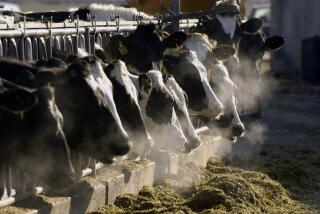Farm Revenues Drop $1 Billion, State Reports
- Share via
SACRAMENTO — Hit hard by the scourges of drought, freeze, recession and whiteflies, California farms suffered an estimated $1-billion drop in revenues last year--in what is likely to be the biggest annual decline ever for the nation’s richest agricultural state.
The steep drop-off in sales of agricultural products underscores the dismal year that many farms struggled through in 1991, and offers a stark contrast to the steady growth that marked the industry’s performance during the last decade.
Despite the drop, agricultural economists say farming remains a stable industry in California. Although most farmers in the Central Valley seem to have weathered the tough year, another bad harvest could result in increased numbers of foreclosures and bankruptcies, experts say.
Farm revenue statewide declined to about 1989 levels, dropping to $17.9 billion from $18.9 billion in 1990, according to a preliminary estimate by the state Department of Food and Agriculture. The estimate is based on statewide surveys taken earlier this year. County reports containing final figures are beginning to trickle in.
The 1991 drop could be even greater than estimated because the three top farm counties--Fresno, Tulare and Kern--have reported combined revenue declines of $944 million. Those three counties represent one-third of California’s harvest.
Imperial County, where white flies ravaged crops last year, has not completed its revenue report.
“The drought and freeze created a serious threat to agriculture, the county’s leading industry,” the Fresno County Department of Agriculture said in a report released this month. “Agricultural revenue and production losses are felt beyond the farm. Farm workers and businesses in the community share in these hardships and losses.”
Fresno County, the leading farm county in the nation, reported an 11.4% decline in farm revenue, or $337 million, to $2.6 billion in 1991. That is slightly above 1989 levels.
In Tulare, the nation’s second-richest farm county, the freeze of late 1990 and early 1991, was blamed for $330 million in revenue drops in the citrus, avocado and olive harvests. Gains in other crops offset these declines somewhat, but Tulare still had a $291-million decline. The value of its 1991 harvest was $1.8 billion.
Kern County was hit by the combined effects of the drought, freeze and recession. An estimated 75,800 acres of cotton land were left idle because of the lack of water in the sixth year of the drought. Making matters worse, demand for cotton was low because of the recession, economists said.
Kern County farmers reported a 17% drop in revenue, or $315 million, for a value of $1.5 billion.
“The farm industry currently, despite the adversity, seems to be pretty well positioned to withstand problems,” said Frederick Cannon, senior economist for Bank of America. “I don’t want to underplay that it was a rough year. But overall, it is a solid industry. It is structured to survive some adversity.”
He said that there have not been more farm bankruptcies because California agriculture went through a major shakeout in the 1980s. Most farmers entered 1991 with relatively little debt, and had been strengthened by several years of gains.
Cannon attributed $200 million of the $1-billion revenue drop to the freeze. Another $200 million was lost in cotton revenues.
A variety of causes including lower producer prices for cheese resulted in a $200-million decline in the dairy and hay industries. The remaining $400 million was a “mixed bag of price and production declines.”
Ray Borton, senior agricultural economist for the state Department of Food and Agriculture, said the $1-billion decline in farm revenue statewide would exceed the $900-million decline between the 1982 and 1983 harvests. The revenue drop a decade ago was attributed largely to changes in the way in which the federal government issued subsidies.
But he also noted that some crops were strong, including high-end wine grapes. Napa and Sonoma counties reported increases. Monterey County, the fourth-richest agricultural county in the state, had a 1.5% increase in revenue.
“Frankly, I was surprised. I thought the drought and freeze would cause more damage,” Fresno County Farm Bureau Manager Bill Allison said.
But Allison noted that this year is off to a bad start in Fresno County. Because of uncertain water supplies and bank mergers, financing is harder to find, and acreage is being held out of production on the western side of the San Joaquin Valley.
“It really looks like a make or break situation for a lot of growers,” Allison said.
In Tulare County, where the local farm bureau sponsored group counseling for farmers and others in the industry who were reeling from the hard times, farm bureau Director Laurena Johnson said that the freeze had “tremendous impact, more than any of us realized.”
“The thing you don’t see in the numbers and report is the human factor,” she added. “The devastation was tremendous.”
Kern County agricultural Commissioner Theodore Davis said he has detected a “slight increase” in farm bankruptcies. But he is holding out hope for a better year this year.
Unless another freeze hits, he said, the citrus crop should rebound. Unlike their counterparts in many counties that depend on federal water supplies, Kern County farmers draw on the State Water Project and local supplies, and figure to receive more water this year.
More to Read
Inside the business of entertainment
The Wide Shot brings you news, analysis and insights on everything from streaming wars to production — and what it all means for the future.
You may occasionally receive promotional content from the Los Angeles Times.










